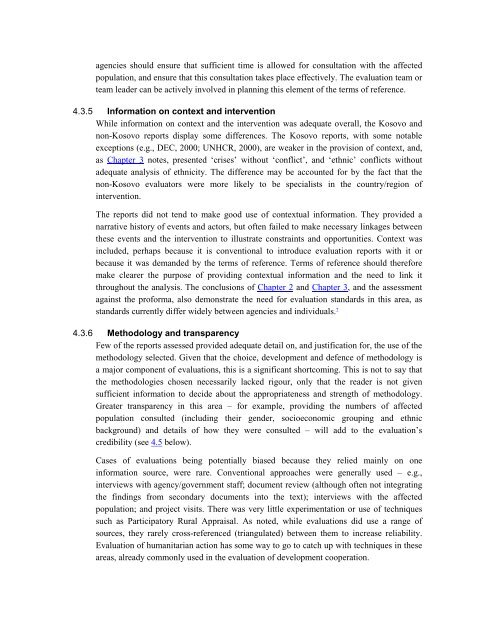Download PDF - ReliefWeb
Download PDF - ReliefWeb
Download PDF - ReliefWeb
Create successful ePaper yourself
Turn your PDF publications into a flip-book with our unique Google optimized e-Paper software.
agencies should ensure that sufficient time is allowed for consultation with the affected<br />
population, and ensure that this consultation takes place effectively. The evaluation team or<br />
team leader can be actively involved in planning this element of the terms of reference.<br />
4.3.5 Information on context and intervention<br />
While information on context and the intervention was adequate overall, the Kosovo and<br />
non-Kosovo reports display some differences. The Kosovo reports, with some notable<br />
exceptions (e.g., DEC, 2000; UNHCR, 2000), are weaker in the provision of context, and,<br />
as Chapter 3 notes, presented ‘crises’ without ‘conflict’, and ‘ethnic’ conflicts without<br />
adequate analysis of ethnicity. The difference may be accounted for by the fact that the<br />
non-Kosovo evaluators were more likely to be specialists in the country/region of<br />
intervention.<br />
The reports did not tend to make good use of contextual information. They provided a<br />
narrative history of events and actors, but often failed to make necessary linkages between<br />
these events and the intervention to illustrate constraints and opportunities. Context was<br />
included, perhaps because it is conventional to introduce evaluation reports with it or<br />
because it was demanded by the terms of reference. Terms of reference should therefore<br />
make clearer the purpose of providing contextual information and the need to link it<br />
throughout the analysis. The conclusions of Chapter 2 and Chapter 3, and the assessment<br />
against the proforma, also demonstrate the need for evaluation standards in this area, as<br />
standards currently differ widely between agencies and individuals. 7<br />
4.3.6 Methodology and transparency<br />
Few of the reports assessed provided adequate detail on, and justification for, the use of the<br />
methodology selected. Given that the choice, development and defence of methodology is<br />
a major component of evaluations, this is a significant shortcoming. This is not to say that<br />
the methodologies chosen necessarily lacked rigour, only that the reader is not given<br />
sufficient information to decide about the appropriateness and strength of methodology.<br />
Greater transparency in this area – for example, providing the numbers of affected<br />
population consulted (including their gender, socioeconomic grouping and ethnic<br />
background) and details of how they were consulted – will add to the evaluation’s<br />
credibility (see 4.5 below).<br />
Cases of evaluations being potentially biased because they relied mainly on one<br />
information source, were rare. Conventional approaches were generally used – e.g.,<br />
interviews with agency/government staff; document review (although often not integrating<br />
the findings from secondary documents into the text); interviews with the affected<br />
population; and project visits. There was very little experimentation or use of techniques<br />
such as Participatory Rural Appraisal. As noted, while evaluations did use a range of<br />
sources, they rarely cross-referenced (triangulated) between them to increase reliability.<br />
Evaluation of humanitarian action has some way to go to catch up with techniques in these<br />
areas, already commonly used in the evaluation of development cooperation.
















![CynefinFramework final [Read-Only]](https://img.yumpu.com/19017304/1/190x135/cynefinframework-final-read-only.jpg?quality=85)